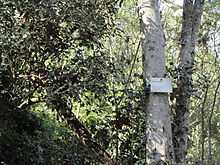Olea woodiana
| Forest olive | |
|---|---|
 | |
| In the KwaZulu-Natal Botanical Garden | |
| Scientific classification | |
| Kingdom: | Plantae |
| (unranked): | Angiosperms |
| (unranked): | Eudicots |
| (unranked): | Asterids |
| Order: | Lamiales |
| Family: | Oleaceae |
| Genus: | Olea |
| Species: | O. woodiana Knobl. |
| Binomial name | |
| Olea woodiana | |
Olea woodiana, known commonly as the Forest olive or black ironwood (Afrikaans: Bosolienhout), is an African tree species belonging to the olive family (Oleaceae).[1]
The tree grows in lower altitude hill forests from Kenya, Tanzania, Swaziland, and South Africa.[2][3]
Description
Olea woodiana is a medium-sized to tall tree.[4] The axillary or terminal inflorescences carry small white flowers that are fragrant.[5]
Fruit are produced from late summer.[4] They are oval-shaped and ripen to a purple black colour, when they are consumed by birds.[4]
Subspecies
There are two recognized subspecies:[3]
- Olea woodiana subsp. disjuncta — Kenya, Tanzania
- Olea woodiana subsp. woodiana — Swaziland, South Africa
References
- ↑ Knoblauch, Emil Friedrich. 1893. Botanische Jahrbücher für Systematik, Pflanzengeschichte und Pflanzengeographie 17: 532 Olea woodiana'
- ↑ "Olea woodiana Knobl.". GRIN Taxonomy for Plants. Germplasm Resources Information Network. Retrieved 26 December 2012.
- ↑ 3.0 3.1 Kew World Checklist of Selected Plant Families Olea woodiana
- ↑ 4.0 4.1 4.2 "Olea woodiana". Witbos inheemse kwekery. Retrieved 26 December 2012.
- ↑ Encyclopedia of Life treatment: ''Olea woodiana . accessed 2.2.2013
External links
| Wikimedia Commons has media related to Olea woodiana. |